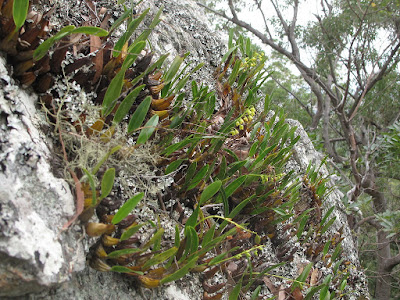Dendrobium monophyllum is found in New South Wales and Queensland, Australia. It grows on trees, rocks and cliffs and on well-lit upper branches of rainforest trees as well as coastal forest at elevations of sealevel to 1000 meters.
Dendrobium monophyllum also called as The Single Leafed Dendrobium, The Lily of the Valley Orchid, Australorchis monophylla, Callista monophylla, Callista tortilis, Dendrobium tortile, is a species of the genus Dendrobium. This species was described by Ferdinand von Mueller in 1859.
IDENTIFY DENDROBIUM MONOPHYLLUM ORCHID PLANT
Dendrobium monophyllum is found in New South Wales and Queensland, Australia. It grows on trees, rocks and cliffs and on well-lit upper branches of rainforest trees as well as coastal forest at elevations of sea level to 1000 meters.
It is a miniature to small sized, cool to hot growing epiphyte or lithophyte with erect, pale green to yellowish, 6-12 cm long and 2-3 cm in diameter stem that becomes ridged with age carrying 1 to rarely 2, oval, thin, dark green, 8-12 cm long, 2.5-3 cm wide leaves.
The Single Leafed Dendrobium blooms in the summer and early fall on an erect, 5 to 10 cm long inflorescence that arises from near the apex of the newest mature pseudobulb and carries from 3 to 20, nodding, bell-shaped, long-lasting and sweet smelling flowers. The flowers are bright yellow, quite pretty when grown in a mass. In its natural state it grows in large masses and often covers large sandstone boulders or trunks of trees.
DENDROBIUM MONOPHYLLUM ORCHID PLANT CARE AND CULTURE
Cultural information should only be used as a guide, and should be to be adapted to suit you. Your physical location; where you grow your plants, how much time you have to devote to their care, and many other factors, will need to be taken into account. Only then can you decide on the cultural methods that best suit you and your plants.
Light:
Dendrobium monophyllum do best in full sunshine (25000-50000 lux), close to the glass where glasshouse treatment is required. In addition to the natural light, you will have to use artificial light lamps.
Temperature:
The average temperature of the summer day is 24-25 ° C, night 20 ° C, giving a daily difference of 4-5 ° C. In winter the average day temperature is 11-14 ° C, night 7-10 ° C, giving a daily difference of 4-5 ° C.
Humidity:
For most of the year, The Single Leafed Dendrobium need the humidity of almost 80%, but at the end of winter and at the beginning of spring it drops to around 60%. Too dry air has a negative effect on the development of the plant: its growth is inhibited, and the leaves begin to turn yellow and dry out. The higher temperature, the higher the humidity should be, and the higher the humidity, the more often and longer it is necessary to ventilate the room where the plants are contained, otherwise the probability of rotting and various kinds of fungal diseases.
Substrate, growing media and repotting:
Dendrobium monophyllum grows best on rafts that are formed by nailing (with copper nails) a number of short lengths of beech or hardwood horizontally across a similar number of perpendicular pieces to form a sort of lattice or grating. The raft is covered with fibre or peat with a little green sphagnum moss, the orchid being fastened thereon with copper wire.
It grows excellently out in the open attached to a piece of peat or a hardwood slab of suitable length and width (usually about 12 inches by 5 inches is satisfactory), or of palmwood or tree fern trunk, to which the plant is bound with copper wire. When hardwood is used, a little fibre should be fastened to the surface to make it easy for the young roots to obtain a grip. Where tree fern is used, the basal part of the trunk, which is covered with thick, fibrous growth, should be used. Where the roots of the orchid are scanty or weak, a little sphagnum between the plant and the block will encourage quick root growth. Where the roots are plentiful and vigorous, however, this is not necessary.
Watering:
The Single Leafed Dendrobium will need heavy watering from the commencement of Summer until the first chill spell of Autumn, when watering should practically cease until the new shoots appear in Spring.
Watering is directly dependent on the temperature of the content, the higher it is, the more often it needs to be watered. When watering, excess water should flow freely from the pot, since stagnation of water both inside the pot and in its pan can very quickly lead to rotting of the roots and the lower part of the plant.
Fertilizer:
It is recommended to use a 1/4-1/2 dose of orchid fertilizer weekly. You can use the balanced fertilizer throughout the year or from spring to mid-summer use high-nitrogen fertilizer, and then until the end of autumn high-phosphoric fertilizer to stimulate flowering.
Rest period:
Dendrobium monophyllum need less water in the winter, especially if they grow under the conditions of a dark, short day that occurs at moderate latitudes. They should dry somewhat between waterings, but they should not be dry for a longer period. Frequent morning fogging and rare, economical watering should allow the plant to go through a dry period of rest, while providing it with sufficient humidity. Fertilization should be reduced or eliminated until new growths appear and a more abundant spring watering begins.

















COMMENTS